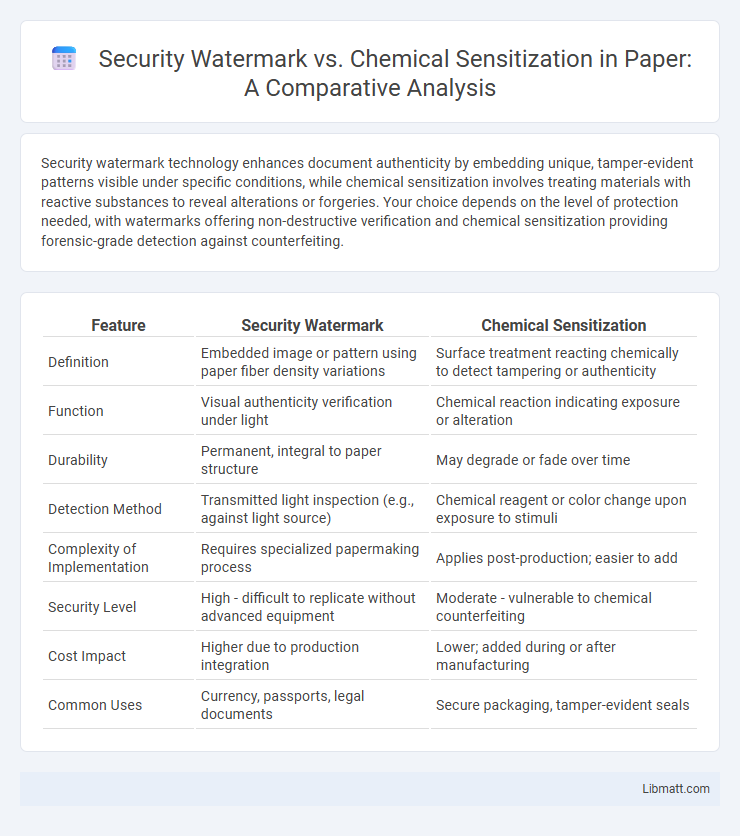Security watermark technology enhances document authenticity by embedding unique, tamper-evident patterns visible under specific conditions, while chemical sensitization involves treating materials with reactive substances to reveal alterations or forgeries. Your choice depends on the level of protection needed, with watermarks offering non-destructive verification and chemical sensitization providing forensic-grade detection against counterfeiting.
Table of Comparison
| Feature | Security Watermark | Chemical Sensitization |
|---|---|---|
| Definition | Embedded image or pattern using paper fiber density variations | Surface treatment reacting chemically to detect tampering or authenticity |
| Function | Visual authenticity verification under light | Chemical reaction indicating exposure or alteration |
| Durability | Permanent, integral to paper structure | May degrade or fade over time |
| Detection Method | Transmitted light inspection (e.g., against light source) | Chemical reagent or color change upon exposure to stimuli |
| Complexity of Implementation | Requires specialized papermaking process | Applies post-production; easier to add |
| Security Level | High - difficult to replicate without advanced equipment | Moderate - vulnerable to chemical counterfeiting |
| Cost Impact | Higher due to production integration | Lower; added during or after manufacturing |
| Common Uses | Currency, passports, legal documents | Secure packaging, tamper-evident seals |
Introduction to Document Security Techniques
Security watermarks utilize embedded patterns visible under specific conditions to authenticate documents and prevent forgery. Chemical sensitization involves treating paper with reactive substances that produce color changes upon exposure to specific chemicals, ensuring document integrity through physical-chemical interaction. Both techniques enhance anti-counterfeiting measures in currency, certificates, and official documents by providing covert and overt verification methods.
What is Security Watermarking?
Security watermarking is a technique used to embed recognizable patterns or images into paper or digital materials to authenticate and prevent counterfeiting. These watermarks are created by varying the thickness or density during paper manufacturing or by incorporating digital algorithms to ensure document integrity. This method enhances security features in currencies, passports, and official documents, making unauthorized replication difficult.
Chemical Sensitization: An Overview
Chemical sensitization involves a skin reaction triggered by repeated exposure to specific chemicals, leading to allergic contact dermatitis characterized by redness, itching, and inflammation. It differs from security watermark technology, which is designed to prevent counterfeiting through visible or invisible markers embedded in documents. Understanding chemical sensitization is critical in occupational health to identify allergens and implement protective measures in environments where chemical exposure is prevalent.
How Security Watermarks Work
Security watermarks embed distinct patterns or images within paper fibers during manufacturing, creating visible or invisible marks that authenticate documents and prevent counterfeiting. These watermarks become apparent when held up to light, revealing intricate designs that are difficult to replicate without specialized equipment. Unlike chemical sensitization, which alters surface properties to detect tampering, security watermarks provide inherent structural security embedded within the material itself.
Mechanism of Chemical Sensitization in Documents
Chemical sensitization in documents involves the application of reactive compounds that interact with paper fibers and inks at a molecular level, altering their chemical structure to create unique markers detectable under specific conditions. This process enhances document authentication by embedding invisible or difficult-to-replicate features that respond to particular reagents or UV light, providing a robust anti-counterfeiting measure. Unlike security watermarks, which rely on physical variations in paper density or thickness, chemical sensitization depends on the precise chemical modification of document components for verification.
Advantages of Security Watermarks
Security watermarks provide a robust anti-counterfeiting measure by incorporating intricate, visible patterns directly into the paper fibers, which are difficult to replicate without specialized equipment. They enhance document authentication through immediate visual verification and maintain durability, resisting wear and chemical exposure that can compromise chemical sensitization. This method reduces reliance on chemical treatments, lowering environmental impact and ensuring long-term security for currencies, passports, and other critical documents.
Benefits of Chemical Sensitization
Chemical sensitization enhances security by enabling dynamic alteration of materials' properties, making counterfeiting significantly more difficult. Your documents or products gain increased authenticity verification through unique chemical reactions that are challenging to replicate. This method offers higher flexibility and durability compared to static security watermarks, improving long-term protection.
Security Watermark vs Chemical Sensitization: Key Differences
Security watermark employs a physical pattern embedded into paper during manufacturing to prevent counterfeiting, offering visible and tactile authentication. Chemical sensitization involves applying reactive chemicals that change color under specific conditions, providing covert verification capabilities. Key differences include watermark's permanence and visual simplicity versus chemical sensitization's reliance on chemical reactions and environmental triggers.
Use Cases and Applications for Each Technique
Security watermarks are primarily used in secure document authentication, currency protection, and brand anti-counterfeiting due to their invisible or semi-visible patterns embedded during paper manufacturing. Chemical sensitization finds applications in forensic science, medical diagnostics, and materials testing by changing color or properties when exposed to specific substances, allowing for rapid detection and analysis. Your choice depends on whether you need long-term, intrinsic security features (security watermark) or reactive, environment-sensitive detection (chemical sensitization).
Future Trends in Document Security Technologies
Future trends in document security technologies emphasize the integration of security watermarks with chemical sensitization techniques to enhance counterfeit detection. Advanced security watermarks using nano-scale patterns combined with chemical sensors allow real-time verification, increasing document authentication accuracy. Innovations in multi-layered security, including smart inks with chemical sensitizers, promise dynamic, tamper-evident solutions for passports, currency, and official certificates.
security watermark vs chemical sensitization Infographic

 libmatt.com
libmatt.com